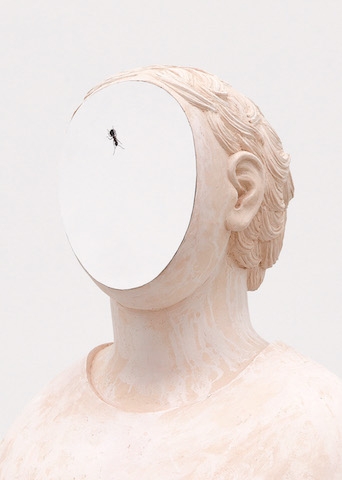The Czech artist Anna Hulačová and her Hungarian contemporary Zsófia Keresztes, both sculptors, share some grounding ideas; they express them, though, in quite different ways. One mutual reference point for their eerie sculptures is Surrealism, and the proto-Surrealist fantasies of Hieronymus Bosch, especially The Garden of Earthly Delights (1490–1500), clearly influence Keresztes’s lurid visions. And that Prague Surrealism, still underappreciated outside the Czech Republic, inspires both artists is made by the inclusion of František Janoušek (1890–1943), a significant figure in the movement, to anchor their work in classic Surrealist practice. Éntomos, named after ἔντομον, the Ancient Greek word for ‘dissection’, ‘insect’ or ‘to offer as a (sacrificial) victim’, places the sculptures of Hulačová and Keresztes alongside Janoušek’s energetic illustrations for Life of the Bee (1901) by the Belgian Symbolist poet Maurice Maeterlinck. The magnificent seventeenth-century Colloredo-Mansfeld Palace is an appropriate location: Janoušek’s drawings are part of the Prague City Gallery collection housed here, and the building’s Baroque interiors contrast Hulačová and Keresztes’s wild imagination.
Hulačová’s work has changed in recent years. Earlier pieces like Cult of Personality (2016) use wood and honeycombs, but she’s recently moved towards concrete sculptures and pencil drawings. Despite this shift, her sculptures still contain recognisably organic figures: human bodies, insects, plantlike things. Their sombre tone has a darkly humorous edge as her characters appear in the colours of pale flesh, ghostly apparitions or grey brutalist architecture. Portrait with an Ant (2017), for example, looks from some angles like a typical bust, with shoulders, a neck, ears and hair made from pale pink ceramic with white streaks. Yet the face, or lack of it, is a shock, replaced with an almost blank white digital print, a single ant crawling across what would once have been a forehead.
This work sets the tone for Hulačová’s other works, in which human body parts are replaced with consumer goods. Series-piece Ascension Mark I (2017), first shown at Frieze London, is just one example of a tool – a rotary shaver – taking the place of a hollowed-out human head. The creature in Praying Mantis and Rotary Shaver (2017), a glass box containing these figures made of Super Sculpey polymer clay, glares menacingly out at the viewer, perched on top of the shaver like a conquered enemy.
Keresztes, meanwhile, is not inspired by humanity’s relation to nature, but virtual reality. She makes nebulous, fluid creatures from ghoulishly pink, yellow and violet glass mosaic tiles, resembling natural oddities from a horticulturalist’s dreams mixed with interior design features from the imperial baths in Budapest. The Safety of Distance (2018) is in portrait format, hanging on the wall, but stubby tentacles protrude from the picture plane as if reaching out from a portal to another dimension. Altar (Sharing Our Final Belongings) (2018) is a strange creature, like a monument honouring the third gender of ‘androgynous creatures, with both male and female elements, descended from the moon’ described in Aristophanes’s speech from Plato’s Symposium. Two congealed, lumbering slabs of bio-matter appear to hover just aboveground. They have horn- or earlike appendages at the top, and a lolling yellow tongue dangling just between their ‘heads’. Though the two halves form one creature, they are constrained by orange ropes with dollops of liquid hanging from the bottom. There are points in the middle where the creature’s clumpy ‘arms’ and ‘legs’ are coiled with rope and swollen like clotted flesh.
Hulačová and Keresztes’s works stand and fall with the current fashionable interest in the Anthropocene. Though this makes their interventions timely, they are both joining and competing with many other artists in questioning whether it is even worth representing human bodies in any conventional sense. The stakes of this kind of work are, nevertheless, shared by all of us, since we all face unprecedented conditions. Not only are we all overwhelmed by ‘cyberblitz’, but the whole species is threatened by ecological crisis, which has already seriously damaged the insect and bee populations necessary to support natural life as we know it. Portrait with an Ant and Altar…, in particular, ask if the reimagination and reconfiguration of organic life is a threat or, perhaps, something to be embraced as a way to survive impending disaster.
Éntomos at Prague City Gallery, Colloredo-Mansfeld Palace, Prague, 21 November – 3 March
From the March 2019 issue of ArtReview
